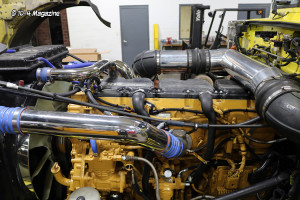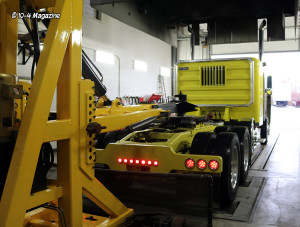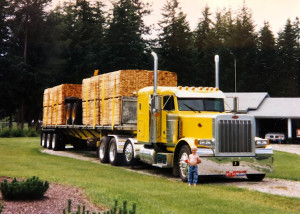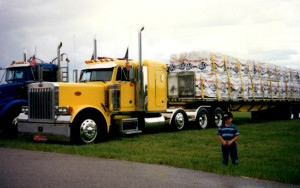Welcome owner operators and students! I have never started an article like this, but I was recently informed that some vocational schools are now using these articles to teach their students my way of building diesel engines, which is very flattering. I guess I better clean up my act, so I don’t pollute the young minds reading these words of wisdom. The first two paragraphs of this article were written by our lead Electrical Engineer Ethan, and they pertain to the emissions systems used on the Detroit DD15 and DD13 exhaust systems, which are commonly referred to as “One Box” by many people.
The DD15 and DD13 “One Box” contains the majority of the after-treatment emissions components all in one unit. The only real advantage to this compact design over other systems is that it saves some space under the truck. One major disadvantage is that the diesel oxidation catalysts (DOC) and the selective catalytic reduction (SCR) elements cannot be replaced without changing the entire unit. Only the diesel particulate filter (DPF) and a few other components can be serviced on the “One Box” system. This causes the cost of repair to increase dramatically, typically around $10,000 after labor, gaskets and, of course, at least one parked regen. Shops usually try to change the “One Box” as a last resort, due to the high cost associated with the repair, but sometimes it is the only option.
In addition to the high cost of repairs, the DD15 system also requires you to validate a repair to clear a check engine light, especially if it deals with the after-treatment system. There are several different levels of codes that the ECM can have – an active code, permanent active code, permanent inactive code, or just inactive. Some codes are easy to repair and the process to clear them out of the ECM is also simple, just hit “clear codes” and you are done. Others, like the permanent codes, cannot be cleared even if the component has been replaced. You must follow the proper procedure for that code, and most of the time it will require a regen to verify the repair. In the case of multiple codes, you may do multiple parked regenerations as part of the repair procedure. Active permanent codes sometimes cannot be completely cleared off the ECM – they will become permanent inactive until a drive cycle is completed, then the ECM will clear the code.
Last week I walked into our engineering center and there was what I thought to be a brand new bright yellow 389 Peterbilt. The hood was tilted, and the truck had a new Acert Cat engine with polished stainless air intake piping, charge air cooler tubes, and even part of the fan shroud was wrapped in polished stainless. I continued to walk around this beautiful Pete and then opened the driver’s side door and noticed the instrument panel was that of a mid-1990’s Peterbilt. Now, I’m thinking, how did that instrument panel get into this new truck? I then walked to the front of the truck and looked at the headlights and realized that this was a reworked 1994 Peterbilt 379!

Sometimes your mind can play funny games with your head, and what you think you’re looking at, really isn’t what it is. Now, I looked at the door for a name and saw AAMODT, INC. Then I realized this was an old friend of mine from Bonners Ferry, Idaho, by the name of Delton Amoth. I spoke with him at the truck show in Louisville this past March, but he did not tell me he was building this 379 Pete. I’ve known this man for a long time, and knew he was capable of building some unique trucks, and now I finally got to see his work.

Delton’s son, Blayne, was the driver, and he told me the story of this Peterbilt. He was 14 months old when his father and mother traveled to Denton, Texas, to watch their new Pete being built. There was one problem – no children were permitted in the assembly plant. The Vice President of Peterbilt heard of the problem, walked out of the office, and said, “I’ll babysit the child, go and watch your truck being built.” So, Blayne got to spend time with the VP of Peterbilt.

This 1994 Pete originally came with a 60 Series DD3 Detroit, which ran for 1.1 million miles, thanks to oil changes every 10,000 to 12,000 miles. After that, a junkyard DD3 Detroit was purchased, with 500,000 miles on it, and then put in the truck. This second engine ran for another 700,000 miles. When this engine wore out, an N-14 525 Celect Plus was installed, and it ran for another 1.1 million miles. The N-14 eventually spun a rod bearing, and at this time the 1994 Pete, with 2.9 million miles, went into the shop for a makeover. The original color was a 1976 Corvette yellow – and it’s still the same, today.

During the makeover of this 1994 Pete 379, an Acert Caterpillar engine was installed. The truck was in our shop for dyno tuning, a new torsional damper and mercury-filled engine balancer. You can see why Blayne is so proud of this 379 – he was only 14 months old when it was built, he got to spend time with the VP of Peterbilt while it was being built, and he was part of the rebuilding process of this wonderful truck, which has almost 3 million miles on the odometer.

Over the years, I have told many owner operators that a Pete or Kenworth can be completely disassembled, down to the last rivet, and rebuilt to be better than new. This particular Peterbilt is proof of that statement – and proof that if taken care of and driven properly, a quality-built truck, like an older Peterbilt, can last a long time! If you have any comments or questions, I can be reached through Pittsburgh Power, Inc. in Saxonburg, PA by calling (724) 360-4080. For more information about all our available products and services, be sure to visit www.pittsburghpower.com today.



